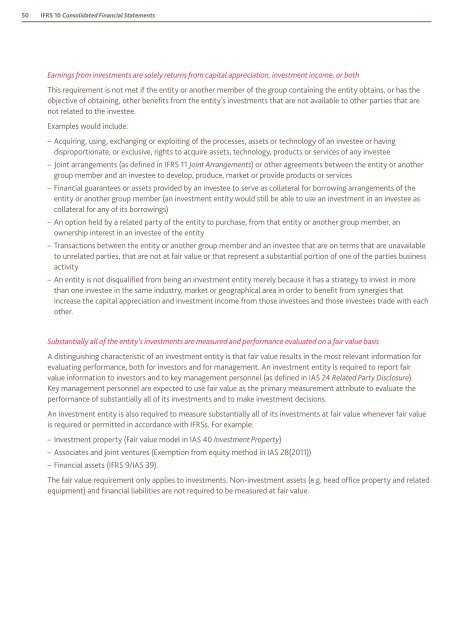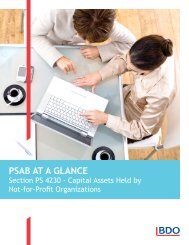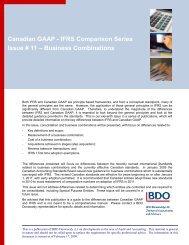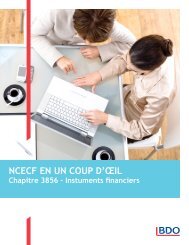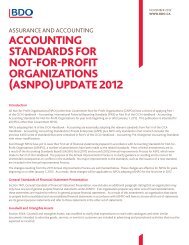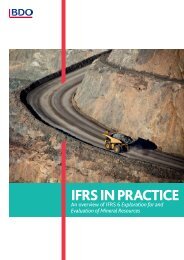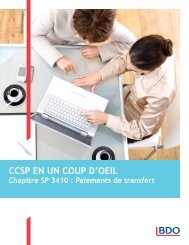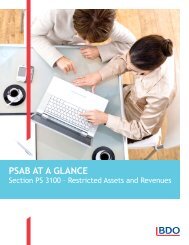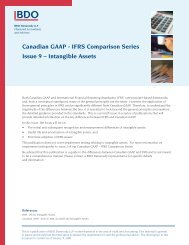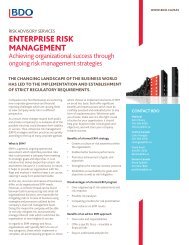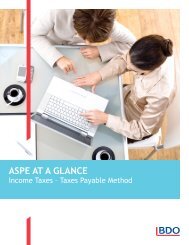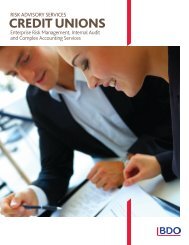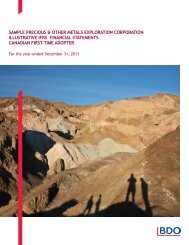Need to Know: IFRS 10 - Consolidated Financial ... - BDO Canada
Need to Know: IFRS 10 - Consolidated Financial ... - BDO Canada
Need to Know: IFRS 10 - Consolidated Financial ... - BDO Canada
- No tags were found...
Create successful ePaper yourself
Turn your PDF publications into a flip-book with our unique Google optimized e-Paper software.
50 <strong>IFRS</strong> <strong>10</strong> <strong>Consolidated</strong> <strong>Financial</strong> StatementsEarnings from investments are solely returns from capital appreciation, investment income, or bothThis requirement is not met if the entity or another member of the group containing the entity obtains, or has theobjective of obtaining, other benefits from the entity’s investments that are not available <strong>to</strong> other parties that arenot related <strong>to</strong> the investee.Examples would include:––Acquiring, using, exchanging or exploiting of the processes, assets or technology of an investee or havingdisproportionate, or exclusive, rights <strong>to</strong> acquire assets, technology, products or services of any investee––Joint arrangements (as defined in <strong>IFRS</strong> 11 Joint Arrangements) or other agreements between the entity or anothergroup member and an investee <strong>to</strong> develop, produce, market or provide products or services––<strong>Financial</strong> guarantees or assets provided by an investee <strong>to</strong> serve as collateral for borrowing arrangements of theentity or another group member (an investment entity would still be able <strong>to</strong> use an investment in an investee ascollateral for any of its borrowings)––An option held by a related party of the entity <strong>to</strong> purchase, from that entity or another group member, anownership interest in an investee of the entity––Transactions between the entity or another group member and an investee that are on terms that are unavailable<strong>to</strong> unrelated parties, that are not at fair value or that represent a substantial portion of one of the parties businessactivity––An entity is not disqualified from being an investment entity merely because it has a strategy <strong>to</strong> invest in morethan one investee in the same industry, market or geographical area in order <strong>to</strong> benefit from synergies thatincrease the capital appreciation and investment income from those investees and those investees trade with eachother.Substantially all of the entity’s investments are measured and performance evaluated on a fair value basisA distinguishing characteristic of an investment entity is that fair value results in the most relevant information forevaluating performance, both for inves<strong>to</strong>rs and for management. An investment entity is required <strong>to</strong> report fairvalue information <strong>to</strong> inves<strong>to</strong>rs and <strong>to</strong> key management personnel (as defined in IAS 24 Related Party Disclosure).Key management personnel are expected <strong>to</strong> use fair value as the primary measurement attribute <strong>to</strong> evaluate theperformance of substantially all of its investments and <strong>to</strong> make investment decisions.An investment entity is also required <strong>to</strong> measure substantially all of its investments at fair value whenever fair valueis required or permitted in accordance with <strong>IFRS</strong>s. For example:––Investment property (Fair value model in IAS 40 Investment Property)––Associates and joint ventures (Exemption from equity method in IAS 28(2011))––<strong>Financial</strong> assets (<strong>IFRS</strong> 9/IAS 39).The fair value requirement only applies <strong>to</strong> investments. Non-investment assets (e.g. head office property and relatedequipment) and financial liabilities are not required <strong>to</strong> be measured at fair value.


